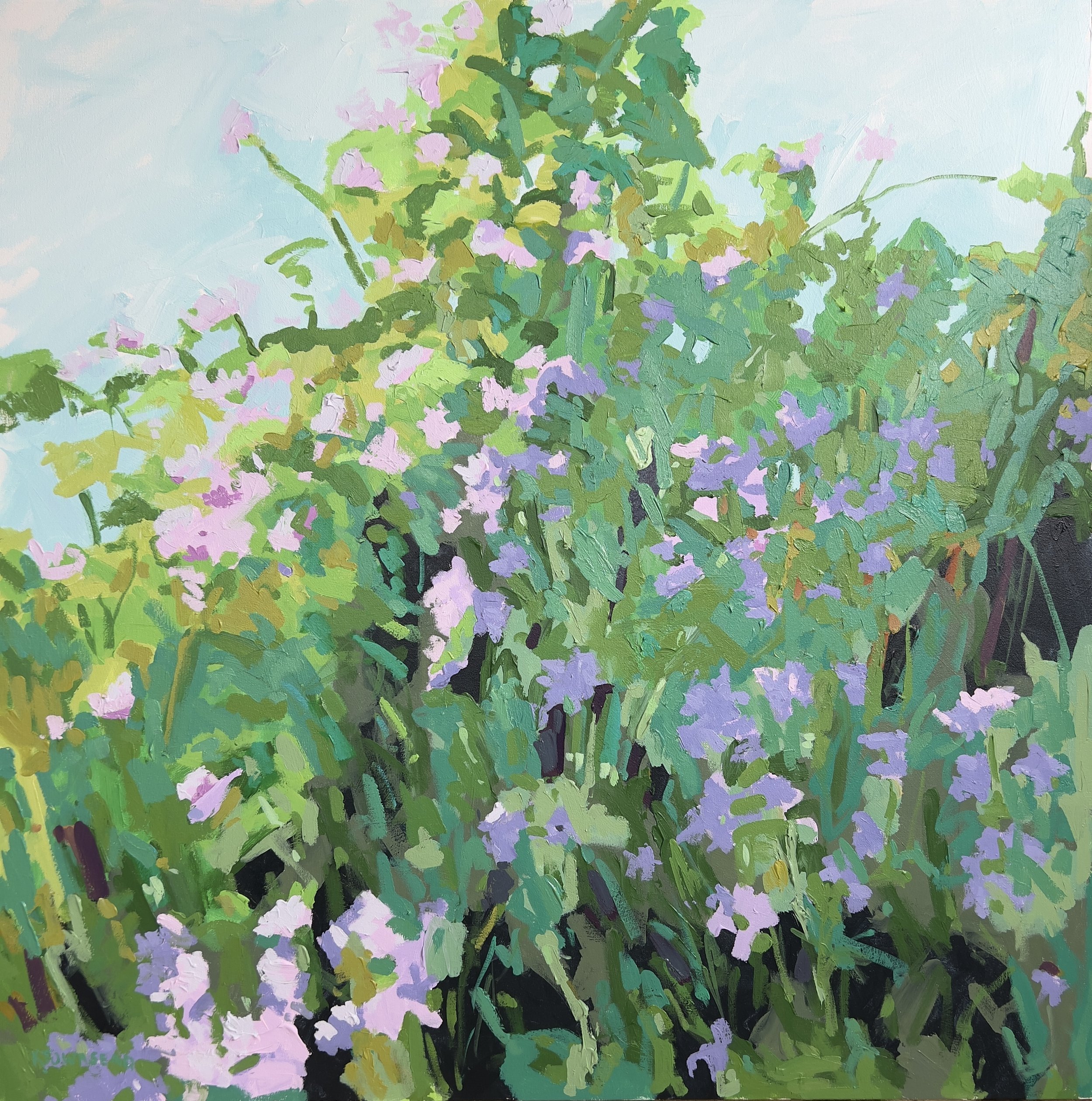Exhibition
Second Nature
Sense memory | Krista Townsend’s ‘Second Nature’ bursts with visual excitement
Review by Sarah Sargent
The C’ville, June 22 2022
Phaeton Gallery
With three shows scheduled for 2022, Krista Townsend found herself in an enviable position as an artist. But she had a problem: She needed work to exhibit. “I realized I had to speed up my process,” says Townsend, who’d primarily worked with oil paint. “I decided to explore using acrylic paint to block in the composition and then work on top of that with oil.”
Working with acrylics entailed a bit of a learning curve as Townsend adjusted to the new medium. Along the way, she discovered that the shorter drying time gave her an advantage. “It was really satisfying to make those marks and then be able to come back quite soon afterwards and work on top of them,” she says. “I soon realized I was sticking with the acrylics longer before putting the oils on top and I just kind of fell in love with them.”
Initially worried that the colors wouldn’t be the same as oil, she ended up being pleasantly surprised. “I love the vibrancy of acrylic colors,” she says. “Especially pinks and reds. I’ve always struggled with getting the reds to sing the way I see them in nature. I also love that I can thin the paint with water and create drips and translucent areas without using toxic oil paint thinners.” Townsend even branched into fluorescent colors, not available in oil. “I bought a few and started to play around with them using them as the underpainting. So, then they were on my palette and I started mixing them with other colors. Some of those purples I can come up with are so vibrant and so much fun. I’ve moved away from using fluorescent colors on their own, but I mix them with other colors to punch up the vibration and make the colors come alive.”
When standing in a room of Townsend’s work at Charlottesville’s new Phaeton Gallery, there’s certainly an abundance of color and texture, but there’s also a potent immediacy. You feel it in the physical way Townsend paints, revealed by the remarkably animated gestural marks, but it’s also there in the way nature is presented. Townsend has a deep relationship with nature, taking daily walks in the woods and meadows surrounding Charlottesville.
On these walks, she absorbs the sights, smells, and feelings of being outdoors in wild places. She takes photographs as reminders of where she’s been and what she’s seen, but mostly she paints her sensory responses to what she’s experienced.
There are so many splendid details in “Ferns and Moss,” an the acrylic on canvas—the wonderfully expressive zigzagging lines of the fern fronds, the mix of moss and plants drooping over windfall and rocks, and the twiggy nest-like accumulation in the lower right. The eye is drawn to bright globs of orange and red paint—a mixture of florescent magenta with cadmium yellow and cadmium red light—of the rotting trunk and branch near the center of the composition. Townsend uses black to great effect here to both describe the dark shadows beneath the plants and to set them off. She effectively brings the woods to you, providing not only a beguiling sylvan vignette, but also inspiring a sense memory of the feel and smell of moist woodsy air.
“Managed Wild Flowers, Early Fall,” an acrylic on canvas, features a muted palette. The painting seems to be composed of separate horizontal zones. Dashes and blobs of paint form the grass and delicate flowers along the bottom. Just above, things get really interesting with a riotous interplay of stalky vegetation and maroon flowers. Above this, a flat expanse of olivey ochre reads like a field of tawny grass. Beyond it, scrawls of greens, browns, and tans describe a tree line set before narrower bands of green, blue, turquoise, and gray that represent another field, distant mountains and sky.
“New Growth” (oil on canvas) depicts an area in Glacier National Park following a controlled burn. The scene could be bleak, but Townsend’s use of color and gesture imbues it with vitality. The bright green at the bottom, signifying the new growth, adds just the right counterpoint to the more subdued palette of the burned area. Townsend finds beauty and drama there with slashes of orange foliage and skeletal charred trees silhouetted against the background.
With “Field of Flowers and Trees” (oil on canvas), Townsend has relinquished all but the scantest narrative elements. There’s much to admire in this glorious work: the color, the texture, the extraordinarily inventive brushwork that captures the exuberance of painting. There’s something captivating about the repeated vertical lines running along the lower part of the painting, representing the stems of flowers, but also providing a pleasing staccato rhythm. Townsend maintains the visual excitement with the fierce tangle of slashes and streaks that constitute the greenery at the top.
Townsend’s paintings are the work of a supremely confident artist who is at the top of her game. In nature, she has found an endlessly inspiring muse that challenges her every day to use talent and intuition to interpret and convey the essence of what is there.
“Townsend’s paintings are the work of a supremely confident artist who is at the top of her game. In nature, she has found an endlessly inspiring muse that challenges her every day to use talent and intuition to interpret and convey the essence of what is there. ”
Examples of the work






